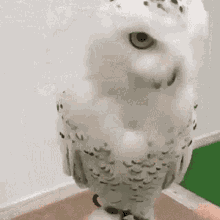SNOWING OWLS

The Snowy Owl is a large white Owl with a rounded head, and barely visible ear-tufts. The name "scandiacus" is a Latinised word referring to Scandinavia, as the Owl was first observed in the northern parts of Europe. Some other names for the Snowy Owl are Snow Owl, Arctic Owl and Ookpik. It is the official bird of Quebec, Canada. Length 51-68.5cm. Wingspan 137-164cm. Tail length 206-241mm. Weight 1134-2000g. Females are larger and heavier than males. Snowy Owls are often assumed to be diurnal due to often being seen during the day, however recent studies have shown them to be more active at night. They have a direct, strong, and steady flight with deliberate, powerful downstrokes and quick upstrokes. They make short flights, close to the ground, from perch to perch, and usually perches on the ground or a low post. During hot weather, they can thermoregulate by panting and spreading their wings. Snowy Owls are very aggressive when defending their nest.
The Snowy Owl is virtually silent during nonbreeding seasons. The typical call of the male is a loud, harsh, grating bark, while the female has a similar higher pitched call. During the breeding season males have a loud, booming "hoo, hoo" given as a territorial advertisement or mating call. Females rarely hoot. Its alarm call is a guttural "krufff-guh-guh-guk". When excited it may emit a loud "hooo-uh, hooo-uh, hooo-uh, wuh-wuh-wuh". Other sounds are dog-like barks, rattling cackles, shrieks, hissing, and bill-snapping. Snowy Owls do not hunt near their nests, so other birds, such as Snow Geese, often nest nearby to take advantage of the Owls driving off predators such as foxes. Snowy Owls produce large, rough-looking cylindrical pellets with numerous bones, feathers, and fur showing. They are usually expelled at traditional roosting sites and large numbers of pellets can be found in one spot. When large prey are eaten in small pieces with little roughage, pellets will not be produced.
Snowy Owls can live at least 9.5 years in the wild and 35 years in captivity. Natural enemies are few - Arctic foxes and wolves prey upon them on their tundra breeding grounds, while skuas and jaegers may take eggs or chicks. The Snowy Owl is a bird of Arctic tundra or open grasslands and fields. In North America, Snowy Owls breed in the western Aleutian Islands, and from northern Alaska, northern Yukon, and Prince Patrick and northern Ellesmere islands south to coastal western Alaska, northern Mackenzie, southern Keewatin, extreme northeastern Manitoba, Southampton and Belcher islands, northern Quebec and northern Labrador. The Snowy Owl is highly nomadic. Every 3-5 years, mass movements of Snowy Owls occur into southern Canada and northern United States.
Unlike many other owls, Snowy Owls are often seen during the daytime. They're excellent hunters and incredibly quiet in flight — true snow ninjas of the north.
← Back to Owl Haven